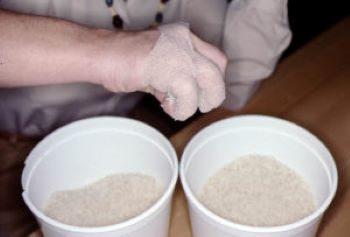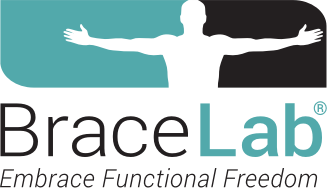Complex Made Simple: Pasta Transfer

October 2013 No. 27
Complex Made Simple: Pasta Transfer
Judy Colditz, OT/L, CHT, FAOTA
HandLab’s byline is “Complex Made Simple,” so we are offering this extremely simple idea for use with your patients.
Gross grasp is usually the earliest function desired following immobilization of the hand after injury/surgery. As the patient’s hand regains motion, progressive exercise activities are needed requiring increasing finger flexion in a synergistic pattern with wrist motion. Loading of both the intrinsic and extrinsic muscles is important because the intrinsic hand muscles are important contributors to grip power. Additionally, any activity progression needs to be simple, inexpensive, and easily replicated by the patient at home. All that is needed for this exercise is a couple of containers/bowls and some pasta.
The activity consists of grasping as many pasta shapes in one container as possible, holding the pasta while transferring to another bowl (with wrist slightly extended), and then releasing…ideally without dropping any pasta!!


Patient transfers rice from one container to another
Instruct the patient to spread the fingers as much as possible to grasp as much pasta as possible, which specifically provides a workout for the interosseous muscles. Although this activity does not appear to have significant resistance, the level of fatigue can be surprising even for an uninjured hand.
Start with a size and shape of pasta the patient can successfully grasp but that requires some effort to hold onto during transfer. If finger flexion is severely limited, the beginning point may be a larger shape such as bow ties, large macaroni, or large shells, etc. As finger flexion increases, choose decreasing sizes of pasta shapes, eventually progressing to small pasta, rice, or even small birdseed. (Try transferring birdseed with your uninjured hand!) The grading of the activity can be controlled by:
1) the size of the containers
2) the size and volume of pasta
3) the number of transfers required
4) the distance between the bowls/containers.
The benefits to the hand are numerous:
1) adaptively shortened interosseous muscles are given a contract-relax workout
2) finger flexion and extension activates lymphatic pumping in the hand
3) wrist stabilization needed for transfer reintegrates the normal tenodesis pattern
4) immersion into the pasta provides sensory input/desensitization
This is the perfect example of a multifaceted exercise accomplished with a very simple, inexpensive solution.
Additional Suggested Reading
Clinical Pearl No. 33 – How Can Each Therapy Visit be as Focused and Productive as Possible?
Clinical Pearl No. 22 – Lumbrical Muscle Tightness & Testing
Clinical Pearl No. 21 – Nuances of Interosseous Muscle Tightness Testing
Clinical Pearl No. 20 – Quantifying Interosseous Muscle Tightness
Clinical Pearl No. 19 – Interosseous Muscle Tightness Testing
Clinical Pearl No. 3 – Making the Most of Mallet Finger Splinting
What Do You See? No. 2 - Finger Scissoring
What Do You See? No. 4 - The Lumbrical-Plus Finger
Video Clip - Drawing the Dorsal Apparatus
Download Clinical Pearl No. 27, Pasta Transfer, October 2013
© BraceLab; 2014 all rights reserved
Disclaimer: BraceLab Clinical Pearls are intended to be an informal sharing of practical clinical ideas; not formal evidence-based conclusions of fact.
